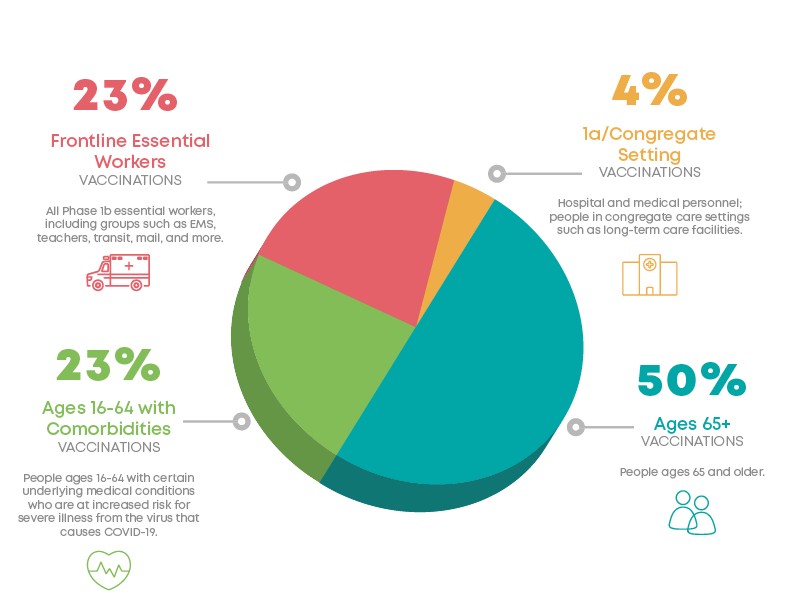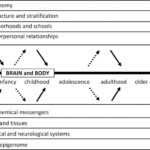As vaccine availability increases, health districts are expanding eligibility, but ensuring vaccines reach the most vulnerable first remains crucial. This article explains how priority is determined within vaccination programs, focusing on risk factors and equitable distribution.
Phase 1a and 1b Eligibility Expansion
Richmond and Henrico Health Districts have broadened vaccine eligibility to include all Phase 1b groups. This significant expansion encompasses frontline essential workers and individuals aged 16-64 with underlying medical conditions and disabilities that elevate their risk of severe COVID-19. Phases 1a and 1b collectively cover a substantial portion of the population in these districts, prioritizing those most vulnerable and frequently exposed. While widespread vaccination will take time, this expansion marks a major advancement in combating the pandemic.
As of March 8th, 2021, the following individuals within Phase 1a and Phase 1b are eligible for COVID-19 vaccination:
- Residents and staff of long-term care facilities
- Healthcare personnel (including primary caregivers for individuals with complex medical needs)
- Individuals aged 65 and older (including those in independent living facilities)
- Residents and staff of correctional facilities and homeless shelters
- Residents and staff of congregate living settings like group homes and recovery residences
- Frontline Essential Workers, including:
- Police, Fire, and Hazmat personnel
- Corrections and homeless shelter staff
- Childcare and PreK-12 educators and staff (public and private)
- Food and Agriculture workers (including veterinarians and food service personnel)
- Manufacturing employees
- Grocery store workers
- Public transportation workers
- Mail carriers (USPS and private)
- Government officials essential for continuity of operations (including judges and public-facing judicial staff)
- Clergy and Faith leaders
- Janitorial and Cleaning staff
Prioritization Framework within Phase 1b
To effectively distribute limited vaccine supplies, health districts implement a prioritization framework. The following chart illustrates the planned vaccine allocation percentages for each priority group within Richmond and Henrico Health Districts as of March 8th. These allocations are dynamic and will adjust as vaccination progresses within early-eligible groups and as vaccine availability fluctuates.
 Pie chart showing vaccine allocation percentages for Phase 1b priority groups
Pie chart showing vaccine allocation percentages for Phase 1b priority groups
In situations where vaccine supply is constrained, state and local health authorities will further refine prioritization within each eligible group. This ensures that individuals at the highest risk receive vaccines first. Richmond and Henrico Health Districts, alongside their partners, will consider several key factors to determine priority access. These factors aim to protect those most susceptible to severe illness, residing in communities with high infection rates, or facing significant barriers to equitable healthcare access.
Continued Priority for Phase 1a and Congregate Care Settings
Richmond and Henrico Health Districts remain committed to providing priority appointments to any remaining Phase 1a healthcare workers and individuals residing in congregate settings. This includes facilities such as jails, group homes, and long-term care facilities, reflecting the ongoing need to protect these high-risk populations.
Focusing on Adults Age 65+
Recognizing the heightened vulnerability of seniors, half of the region’s vaccine supply is dedicated to individuals aged 65 and older. Within this age group, a structured framework is applied to prioritize pre-registered seniors:
- Age: Older seniors within this group are prioritized for earlier vaccination appointments, acknowledging increased risk with advancing age.
- Race and Ethnicity: Black, Hispanic/Latinx, and American Indian or Alaska Native residents are given priority due to disproportionately higher rates of infection and severe outcomes in these communities.
- Burden of Disease: Priority is given to residents living in areas with higher rates of infection, hospitalization, and mortality, reflecting community-level risk.
- Social Vulnerability Score (SVI): The SVI of a resident’s area is considered, prioritizing those in more vulnerable communities (see detailed note below).
Prioritizing Frontline Essential Workers
Similar to the approach for seniors, frontline essential workers who pre-register for vaccination are prioritized based on a comparable framework:
- Age: Older essential workers are prioritized, aligning with age-related risk factors.
- Race and Ethnicity: Priority is extended to Black, Hispanic/Latinx, and American Indian or Alaska Native essential workers to address health disparities.
- Burden of Disease: Essential workers in areas with higher disease burden are prioritized, reflecting community transmission levels.
- Social Vulnerability Score (SVI): SVI is used to prioritize essential workers residing in vulnerable communities.
- Level of Work-Based Exposure: The degree of occupational exposure risk is a crucial factor in prioritizing essential workers. Detailed guidelines on exposure risk levels can be found at OSHA guidelines.
Essential workers over 65 or aged 16–64 with high-risk medical conditions or disabilities who have pre-registered through Vaccinate Virginia may receive vaccination appointments and access to vaccines sooner than other coworkers due to their inclusion in multiple priority categories within Phase 1b.
Workplace-Level Prioritization for Essential Workers
Beyond individual prioritization, Richmond and Henrico Health Districts also assess entire workplaces and workforce groups to gauge collective risk and exposure levels. Employers are requested to provide data on the following metrics to inform risk assessment:
- Proportion of employees with elevated workplace exposure risk.
- Percentage of employees who identify as Black, Hispanic/Latinx, and/or American Indian or Alaska Native.
- Percentage of employees aged 65 and over.
- Percentage of employees without workplace-provided health insurance.
- Percentage of employees with limited English proficiency.
- Percentage of employees with a high school diploma or less.
Workplaces and workforce groups exhibiting elevated risk and vulnerability may be offered coordinated vaccination pathways. These may include large-scale vaccination events or appointment scheduling across multiple dates and times to accommodate diverse work schedules.
Health districts are actively engaging with regional employers. Businesses or organizations in Phase 1b not yet contacted by RHHD should complete the organization form promptly.
Individuals Aged 16-64 with Underlying Conditions and Disabilities
A portion of the weekly vaccine allocation from Richmond and Henrico Health Districts is directed to free clinics, community health centers, primary care providers, specialist outpatient clinics, and health systems. This distribution network facilitates vaccination for existing patients aged 16–64 with underlying medical conditions or disabilities. Providers are instructed to consider these factors when selecting patients for vaccination within this group:
- Age: Older individuals within this age bracket are prioritized.
- Race and Ethnicity: Black, Hispanic/Latinx, and American Indian or Alaska Native patients are prioritized to address health equity.
- Socioeconomic Status: Priority is given to underinsured and uninsured residents, recognizing socioeconomic barriers to healthcare access.
Eligible individuals without a primary care provider can access vaccination through Richmond and Henrico Health Districts’ vaccination events. Pre-registration through the statewide portal is required, and registration team members will provide follow-up contact.
How to Get Vaccinated
Pre-registration is essential for anyone seeking vaccination and can be completed at vaccinate.virginia.gov. Pre-registration is open to all individuals, regardless of current phase eligibility. The Vaccinate Virginia website allows individuals to check their registration status at any time.
For those unable to pre-register online, assistance is available by phone at 1-877-VAX-IN-VA (1-877-829-4682). Representatives offer support in English and Spanish, with callback options in 100 additional languages.
Health department staff will contact pre-registered individuals via phone or email to guide them through the appointment scheduling process for vaccination events or designated partner vaccination sites. Vaccinations are by appointment only through various pathways:
- Large, small, and mobile RHHD vaccination events across the region
- Safety-net clinics including Capital Area Health Network, Crossover, Health Brigade, and Daily Planet Health Services
- Urgent care providers like Patient First
- Health Systems such as Bon Secours Richmond, HCA, and VCU Health System
- Primary Care Providers in participating communities
- Local pharmacies, including Hope, Westwood, and Bremo pharmacies
- Retail pharmacies like CVS and Walgreens
To promote equitable vaccine access for all eligible residents, Richmond and Henrico Health districts will also operate pop-up clinics in communities with limited technology or transportation access. Partnerships with faith-based and community organizations will continue to expand outreach and promote vaccination within their communities.
Vaccination options are expected to increase as vaccine supply grows in the coming months.
Understanding the CDC’s Social Vulnerability Index
The Social Vulnerability Index (SVI), developed by the CDC, identifies communities most likely to face increased hardship during emergencies like the COVID-19 pandemic. The SVI considers community-wide factors such as race, language, poverty rates, employment, education levels, transportation access, homeownership, and single-parent households. In Richmond and Henrico, neighborhoods with high SVI scores exhibit higher rates of infection, hospitalization, and mortality. These areas are also more likely to have predominantly Black, Latinx, or older populations.
